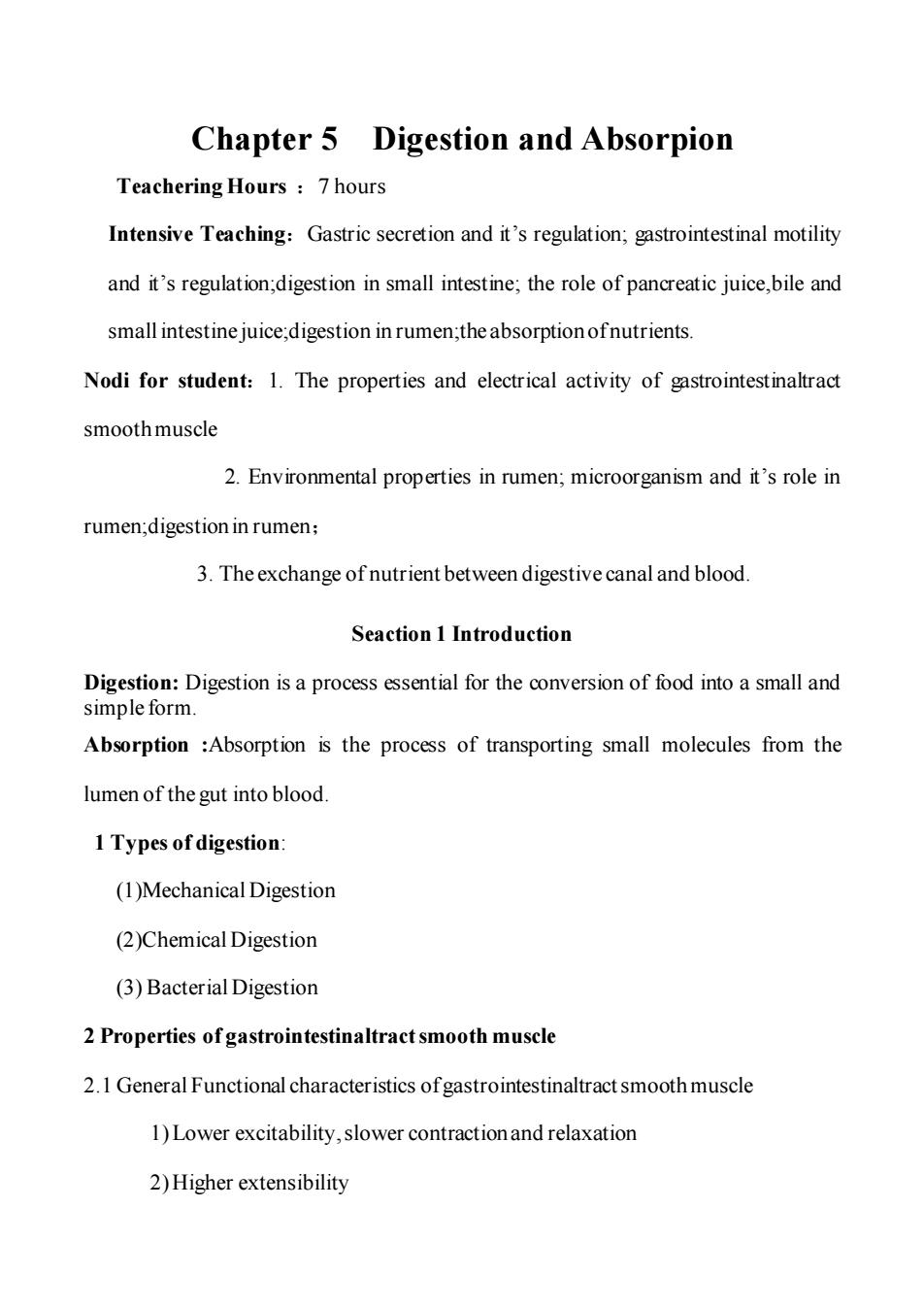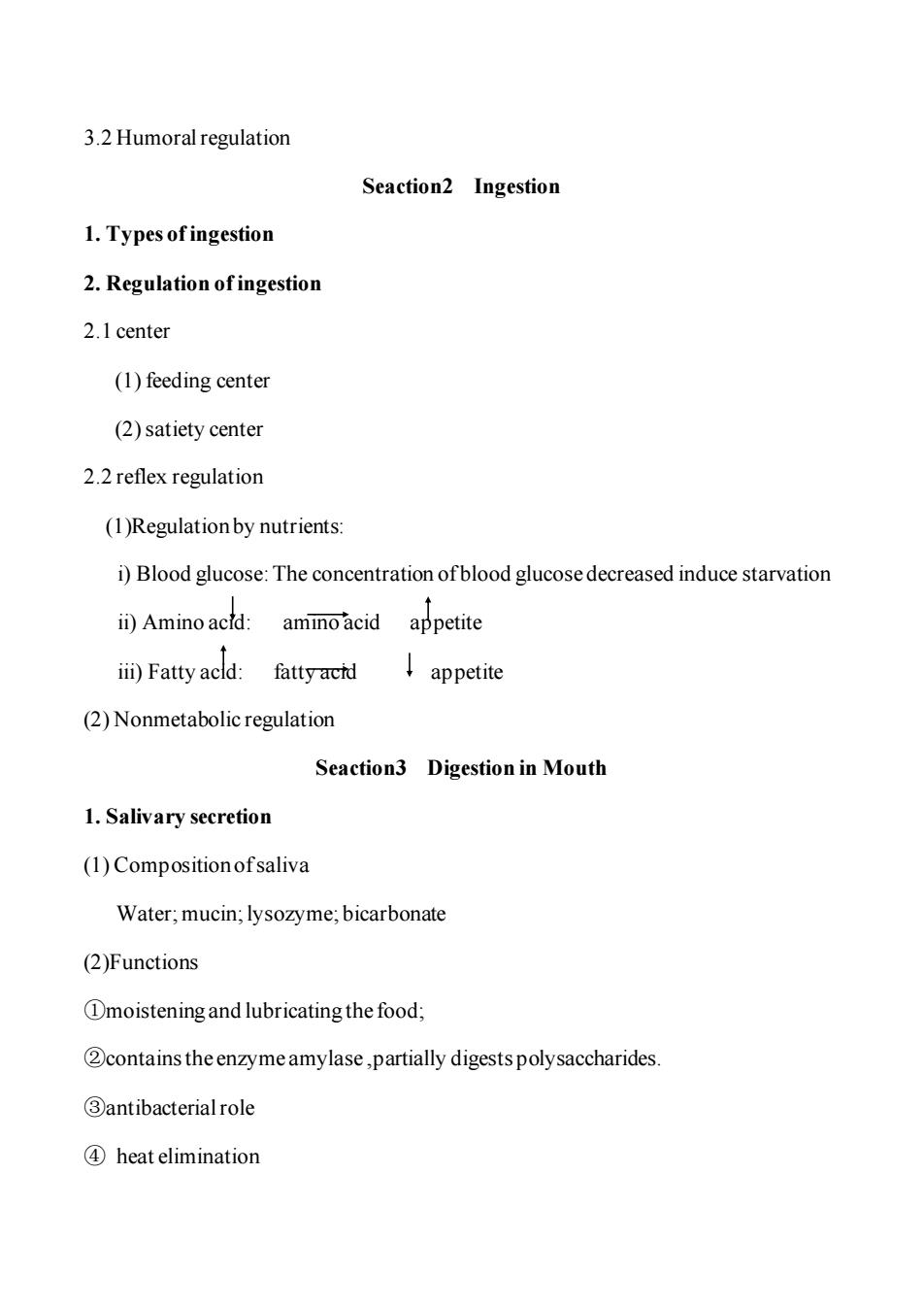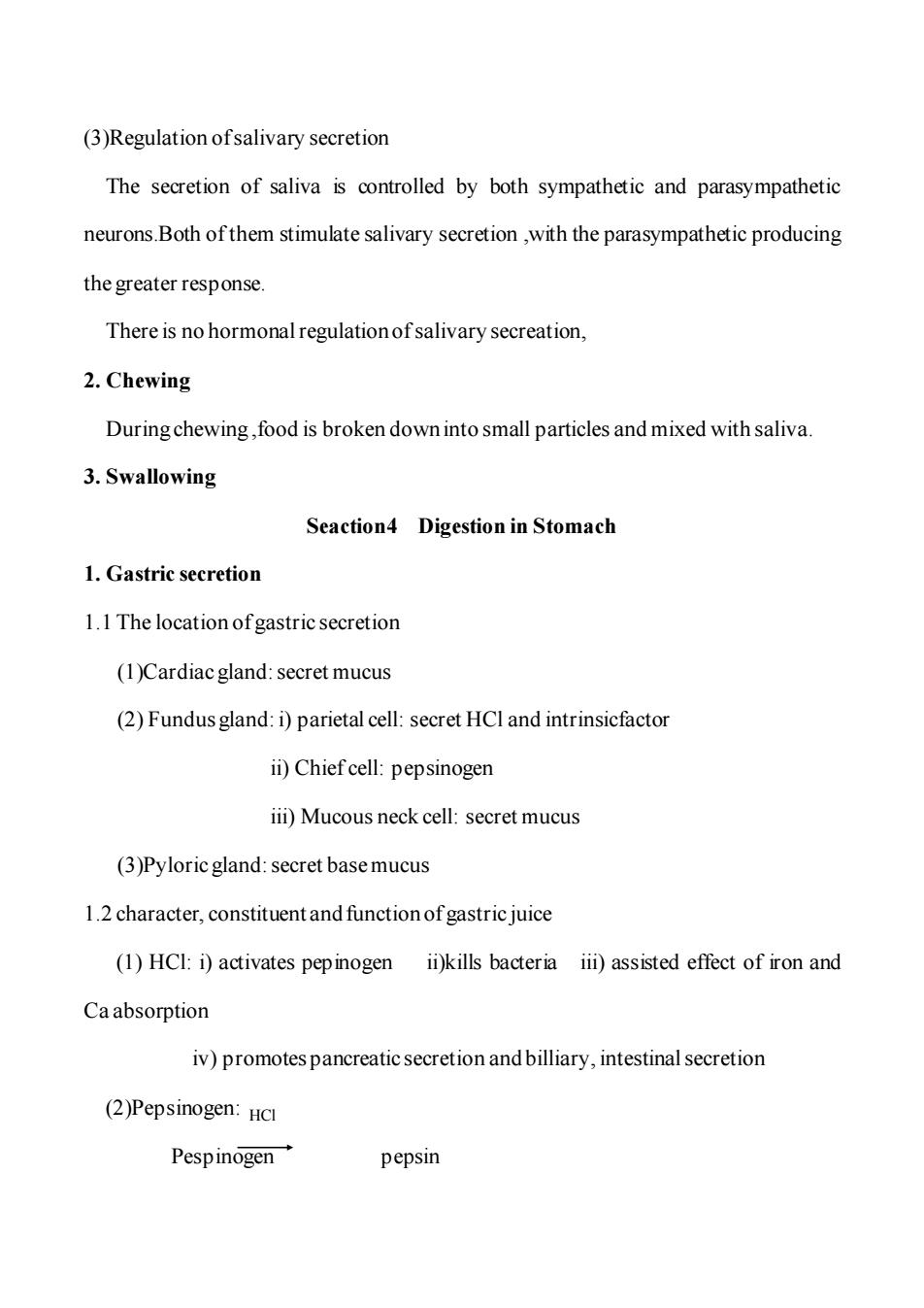
Chapter 5 Digestion and Absorpion Teachering Hours 7 hours Intensive Teaching:Gastric secretion and it's regulation;gastrointestinal motility and it's regulation;digestion in small intestine;the role of pancreatic juice,bile and small intestine juice:digestion in rumen;the absorption ofnutrients Nodi for student:1.The properties and electrical activity of gastrointestinaltract smooth muscle 2.Environmental properties in rumen;microorganism and it's role in rumen;digestion in rumen; 3.The exchange of nutrient between digestive canal and blood. Seaction 1 Introduction Digestion:Digestion is a process essential for the conversion of food into a small and simple form. Absorption Absorption is the process of transporting small molecules from the lumen of the gut into blood. 1 Types of digestion: (1)Mechanical Digestion (2)Chemical Digestion (3)Bacterial Digestion 2 Properties of gastrointestinaltract smooth muscle 2.1 General Functional characteristics ofgastrointestinaltract smooth muscle 1)Lower excitability,slower contraction and relaxation 2)Higher extensibility
Chapter 5 Digestion and Absorpion Teachering Hours :7 hours Intensive Teaching:Gastric secretion and it’s regulation; gastrointestinal motility and it’s regulation;digestion in small intestine; the role of pancreatic juice,bile and small intestine juice;digestion in rumen;the absorption of nutrients. Nodi for student:1. The properties and electrical activity of gastrointestinaltract smooth muscle 2. Environmental properties in rumen; microorganism and it’s role in rumen;digestion in rumen; 3. The exchange of nutrient between digestive canal and blood. Seaction 1 Introduction Digestion: Digestion is a process essential for the conversion of food into a small and simple form. Absorption :Absorption is the process of transporting small molecules from the lumen of the gut into blood. 1 Types of digestion: (1)Mechanical Digestion (2)Chemical Digestion (3) Bacterial Digestion 2 Properties of gastrointestinaltract smooth muscle 2.1 General Functional characteristics of gastrointestinaltract smooth muscle 1)Lower excitability, slower contraction and relaxation 2) Higher extensibility

3)Tonic contraction 4)Autorhythmicity 5)More sensitive to stretch,chemicals,cold and warm stimulation but not to electric stimulation 2.2 Electrical activity of gastrointestinaltract smooth muscle (1)Resting potential:-55~-60mv.Mainly determined by K+equilibrium potential, Related also with Na+and Ca2+ (2)Slow wave or basic electric rhythm (BER):Basic electrical rhythm is the spontaneous rhythmic,subthreshold depolarization of the cell membrane in the gastrointestinal tract.BER are not action potential,but show undulating changes in the resting membrane potential. (3)Action potential:(i)Action potential can only be generated on the background of slow wave potential. (ii)The ionic basis ofaction potential is determined by Ca2+influx. (iii)The amplitude of smooth muscle contraction depends on number of action potential generated Slow waves are changes in resting membrane potential.Always present but do not always cause contractions. 3 Regulation of gastrointestinal function 3.1 Automic nervous system (1)Sympathetic nerveamd Parasympathetic nerve (2)Intrinsic nervous system:myenteric plexus;submucosal plexus
3) Tonic contraction 4) Autorhythmicity 5) More sensitive to stretch, chemicals, cold and warm stimulation but not to electric stimulation 2.2 Electrical activity of gastrointestinaltract smooth muscle (1)Resting potential:-55~-60mv. Mainly determined by K+ equilibrium potential, Related also with Na+ and Ca2+ (2)Slow wave or basic electric rhythm (BER): Basic electrical rhythm is the spontaneous rhythmic, subthreshold depolarization of the cell membrane in the gastrointestinal tract. BER are not action potential, but show undulating changes in the resting membrane potential. (3)Action potential: (i) Action potential can only be generated on the background of slow wave potential. (ii)The ionic basis of action potential is determined by Ca2+ influx. (iii)The amplitude of smooth muscle contraction depends on number of action potential generated Slow waves are changes in resting membrane potential. Always present but do not always cause contractions. 3 Regulation of gastrointestinal function 3.1 Automic nervous system (1)Sympathetic nerve amd Parasympathetic nerve (2) Intrinsic nervous system: myenteric plexus; submucosal plexus

3.2 Humoral regulation Seaction2 Ingestion 1.Types of ingestion 2.Regulation of ingestion 2.1 center (1)feeding center (2)satiety center 2.2 reflex regulation (1Regulation by nutrients: i)Blood glucose:The concentration ofblood glucose decreased induce starvation i)Amino acid: amino acid appetite ii)Fatty acld: fatty acid appetite (2)Nonmetabolic regulation Seaction3 Digestion in Mouth 1.Salivary secretion (1)Compositionofsaliva Water;mucin;lysozyme;bicarbonate (2)Functions Dmoistening and lubricating the food; 2contains the enzyme amylase,partially digests polysaccharides. ③antibacterial role ④heat elimination
3.2 Humoral regulation Seaction2 Ingestion 1. Types of ingestion 2. Regulation of ingestion 2.1 center (1) feeding center (2) satiety center 2.2 reflex regulation (1)Regulation by nutrients: i) Blood glucose: The concentration of blood glucose decreased induce starvation ii) Amino acid: amino acid appetite iii) Fatty acid: fatty acid appetite (2) Nonmetabolic regulation Seaction3 Digestion in Mouth 1. Salivary secretion (1) Composition of saliva Water;mucin; lysozyme; bicarbonate (2)Functions ①moistening and lubricating the food; ②contains the enzyme amylase ,partially digests polysaccharides. ③antibacterial role ④ heat elimination

(3)Regulation ofsalivary secretion The secretion of saliva is controlled by both sympathetic and parasympathetic neurons.Both of them stimulate salivary secretion,with the parasympathetic producing the greater response. There is no hormonal regulation of salivary secreation, 2.Chewing During chewing,food is broken down into small particles and mixed with saliva 3.Swallowing Seaction4 Digestion in Stomach 1.Gastric secretion 1.1 The location of gastric secretion (1)Cardiac gland:secret mucus (2)Fundus gland:i)parietal cell:secret HCl and intrinsicfactor ii)Chief cell:pepsinogen iii)Mucous neck cell:secret mucus (3)Pyloric gland:secret base mucus 1.2 character,constituent and function of gastric juice (1)HCI:i)activates pepinogen ii)kills bacteria iii)assisted effect of iron and Ca absorption iv)promotes pancreatic secretion and billiary,intestinal secretion (2)Pepsinogen:HCI Pespinogen pepsin
(3)Regulation of salivary secretion The secretion of saliva is controlled by both sympathetic and parasympathetic neurons.Both of them stimulate salivary secretion ,with the parasympathetic producing the greater response. There is no hormonal regulation of salivary secreation, 2. Chewing During chewing ,food is broken down into small particles and mixed with saliva. 3. Swallowing Seaction4 Digestion in Stomach 1. Gastric secretion 1.1 The location of gastric secretion (1)Cardiac gland: secret mucus (2) Fundus gland: i) parietal cell: secret HCl and intrinsicfactor ii) Chief cell: pepsinogen iii) Mucous neck cell: secret mucus (3)Pyloric gland: secret base mucus 1.2 character, constituent and function of gastric juice (1) HCl: i) activates pepinogen ii)kills bacteria iii) assisted effect of iron and Ca absorption iv) promotes pancreatic secretion and billiary, intestinal secretion (2)Pepsinogen: Pespinogen pepsin HCl

Hydrolyze protein (3)Mucus:lubrication,protection Mucus-HCO3 barrier:Mucus-HCO3-barrier is an alkaline gel layer of mucus which is mainly insoluble and coats the stomach mucosa.The importance functions of the mucus-HCO3-barrier are protecting the gastric mucosa against injury by acid or pepsin,and contributing to lubrication offood transport. (4)intrinsicfactor:forming complex with B12,combined with the receptor in ileum to promote B12 absorption 1.3 Regulation ofgastricjuice secretion (1)Cephalic phase:The cephalic phase is initiated when receptors in the head are stimulated by sight,smell,taste,and chewing.There are nervous and humoral mechanisms involved in this phase. Vagus什 release Ach↑ gastric secretion stimulate G cells secretion Characteristics:Approximately 30%of total gastric juice with higher acidity and pepsinogen is secreted in cephalic phase. (2)Gastric phase:Once food enters the stomach,it excites i)long vagovagal reflexes,ii)local enteric reflexes,and iii)the gastrin mechanism,all of which in turn cause secretion of gastric juice during several hours while the food remains in the stomach.. (3)Intestinal phase:
Hydrolyze protein (3)Mucus: lubrication, protection Mucus-HCO3 barrier: Mucus-HCO3- barrier is an alkaline gel layer of mucus which is mainly insoluble and coats the stomach mucosa. The importance functions of the mucus- HCO3- barrier are protecting the gastric mucosa against injury by acid or pepsin, and contributing to lubrication of food transport. (4) intrinsicfactor: forming complex with B12, combined with the receptor in ileum to promote B12 absorption 1.3 Regulation of gastric juice secretion (1)Cephalic phase: The cephalic phase is initiated when receptors in the head are stimulated by sight, smell, taste, and chewing.There are nervous and humoral mechanisms involved in this phase. Vagus (+) release Ach gastric secretion stimulate G cells secretion Characteristics: Approximately 30% of total gastric juice with higher acidity and pepsinogen is secreted in cephalic phase. (2) Gastric phase: Once food enters the stomach, it excites i) long vagovagal reflexes, ii) local enteric reflexes, and iii) the gastrin mechanism, all of which in turn cause secretion of gastric juice during several hours while the food remains in the stomach.. (3) Intestinal phase: